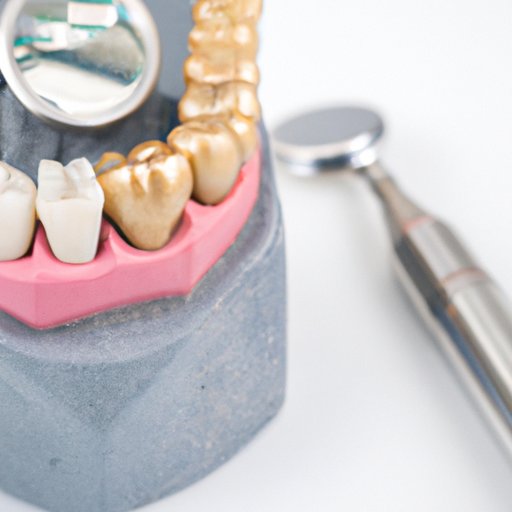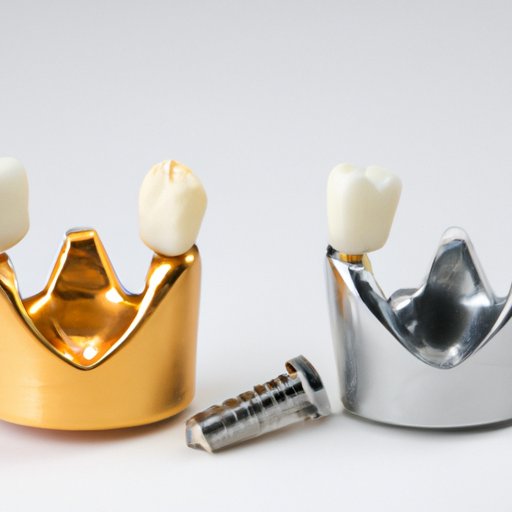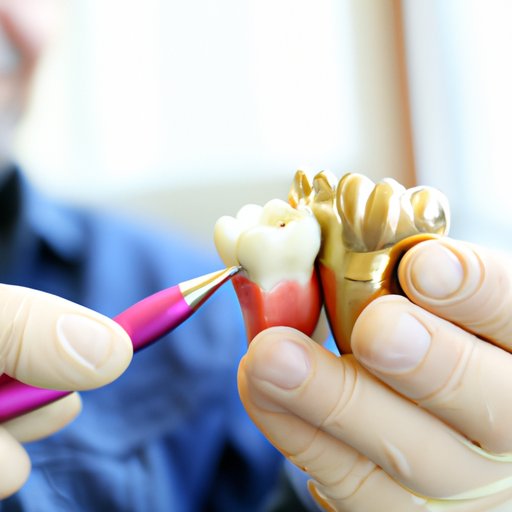Introduction
A dental crown is a cap that is placed over a damaged or decayed tooth in order to restore it to its original shape, size, and strength. It is typically made of porcelain, metal, or a combination of both, and is designed to match the color of your existing teeth. A crown may be necessary if you have a large cavity, a cracked or broken tooth, or a root canal. But how often do crowns need to be replaced?
Examining the Lifespan of Dental Crowns: How Often Do They Need Replacing?
The answer to this question depends on several factors, including the type of crown, the material used, and the patient’s oral hygiene habits. Generally speaking, crowns can last anywhere from five to fifteen years, with most lasting about ten years. However, some patients may find that their crowns need to be replaced sooner due to wear and tear or damage.
There are several types of crowns available, each with its own average lifespan. Porcelain-fused-to-metal (PFM) crowns are the most popular option, as they are strong and durable yet still look natural. These crowns typically last about five to eight years. All-porcelain crowns, which are made entirely of porcelain, are also popular, as they look more natural than PFM crowns. These crowns typically last seven to ten years. Gold crowns are the strongest and most durable option, but they are not as aesthetically pleasing. Gold crowns typically last ten to fifteen years.
The average cost of replacing a crown ranges from $500 to $3,000 depending on the type of crown and the dentist. Most insurance companies will cover at least part of the cost, so it’s important to check with your provider before making any decisions.

What You Need to Know About Replacing Dental Crowns
There are several reasons why a crown may need to be replaced, such as decay, a chipped or cracked tooth, or a root canal. In some cases, the crown may simply need to be adjusted or tightened. If the crown is severely damaged, however, it will need to be replaced.
Replacing a dental crown typically involves several steps. First, the old crown must be removed and the underlying tooth prepared for the new crown. Then, an impression of the tooth is taken and sent to a lab where the new crown is custom-made. Once the crown is ready, it is fitted onto the tooth and secured in place. Finally, the dentist will make any necessary adjustments to ensure a comfortable fit.
Potential complications associated with crown replacement include gum irritation, sensitivity to hot and cold, and a poor fit. If any of these issues occur, it is important to contact your dentist right away.
Common Questions About Replacing Dental Crowns
Can a crown be replaced without removing it? In some cases, a crown may be able to be re-cemented without being removed. However, this should only be done if the crown is in good condition and does not require any further work.
Is it possible to replace a crown without anesthesia? Yes, it is possible to replace a crown without anesthesia, although it is not recommended. Most dentists will use a local anesthetic to ensure the patient is comfortable during the procedure.
Is it possible to repair a broken crown? In some cases, a broken crown can be repaired. The dentist will examine the crown to determine whether it can be salvaged or needs to be replaced.

The Pros and Cons of Replacing Dental Crowns
Replacing a dental crown has both advantages and disadvantages. On the plus side, a new crown can restore the appearance of the tooth, improve function, and reduce pain or sensitivity. On the downside, crown replacement can be expensive and time consuming. Additionally, the procedure can cause discomfort and there is always the risk of complications.

Understanding When a Dental Crown Should Be Replaced
It is important to understand the signs that indicate a crown needs to be replaced. These include discoloration, visible cracks or chips, and loose or ill-fitting crowns. If you experience any of these symptoms, it is important to visit your dentist right away. Failing to replace a damaged crown can lead to further damage to the tooth, infection, and even tooth loss.
How Long Does a Dental Crown Last?
The longevity of a dental crown depends on several factors, including the type of crown, the material used, and the patient’s oral hygiene habits. There are several steps you can take to increase the lifespan of your crown, such as brushing and flossing regularly, avoiding hard or sticky foods, and visiting the dentist for regular check-ups.
Tips for Maintaining Your Dental Crowns
Regular brushing and flossing are key to maintaining healthy teeth and gums and ensuring your dental crowns last as long as possible. It is also important to avoid hard or sticky foods, which can damage the crown. Finally, it is essential to visit the dentist for regular check-ups in order to detect any problems early on.
Conclusion
In conclusion, dental crowns can last anywhere from five to fifteen years, depending on the type of crown, the material used, and the patient’s oral hygiene habits. It is important to understand the signs that indicate a crown needs to be replaced and to take steps to maintain your crowns. With proper care and maintenance, your crowns can last for many years.
(Note: Is this article not meeting your expectations? Do you have knowledge or insights to share? Unlock new opportunities and expand your reach by joining our authors team. Click Registration to join us and share your expertise with our readers.)
